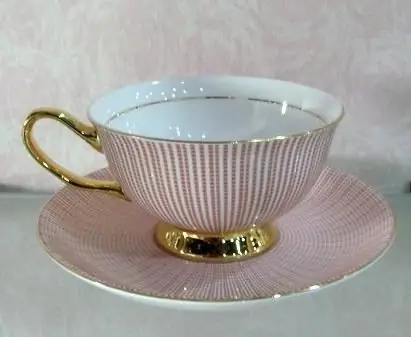2026 Author: Priscilla Miln | [email protected]. Last modified: 2025-01-22 17:55:23
If architecture is music frozen in stone, porcelain is probably moonlight frozen. It is common knowledge that porcelain was invented in China in the 6th century. The secret of its production was guarded so strictly that only in the 16th century did Japan begin to produce products similar to Chinese ones. Porcelain according to the composition of the porcelain mass is divided into hard and soft. And a kind of link between them is bone china. This precious type of ceramics is also called "white gold". And it's not just the price or the uniqueness of production. Products from it can be attributed to works of art, perfect in their structure and form.

Birth Story
Looking at the white, with a delicate shade of baked milk, an almost transparent fragile miracle, it is hard to believe that the finished porcelain is fired at a temperature of 1250 degrees, glaze is applied and fired again, lowering the temperature by 100 degrees. Bone china was first invented in England in the middle of the 18th century at the factory of Joshua Wedgwood. For many years, the monopoly on the production of products from it belonged to England. And the secret was that in the traditional liquid mass for making porcelain (a mixture of kaolin, spar and quartz), up to50 percent burnt bone meal. It was she who gave the products amazing properties: lightness, translucency, smoothness and strength. But bone ash had to be prepared in a special way, so that bone china would become that precious substance, the production of which was so zealously guarded by the British. Fortunately, any secrets are sure to become known. Porcelain made in England conquered Europe and then Asia. Ironically, China began to use bone china almost later than all other countries.

Conquest of Russia
Majolica production was developed in Russia by the middle of the 18th century. Massive products made of majolica were not inferior in quality to European ones. Even Peter I aspired to create a porcelain production in Russia, ordering him to find out the secret of making porcelain in Meissen. The attempt failed. Therefore, in 1724, at the faience factory of the merchant Grebenshchikov, and later at the St. Petersburg manufactory, they began to develop their own technological production. In St. Petersburg in 1744, the Lomonosov, or otherwise the Imperial, Porcelain Factory was founded, which became the first in Russia to produce porcelain. It was here that snuffboxes were made for Empress Elizabeth Petrovna, and then larger items: vases, sets and, finally, dolls. The products of the Lomonosov Porcelain Factory (LFZ) were not much inferior in quality to the Chinese ones, but were much cheaper. What about bone china? It began to be produced at the Lomonosov Porcelain Factory only in 1969. The first Russian product from thismaterial was a cup. It took more than two years to develop the recipe, but LFZ bone china turned out to be of higher quality than English, thinner, whiter and more transparent. For its development, the plant's specialists were awarded the State Prize of the USSR. To this day, the Lomonosov Porcelain Factory is the only one in Russia that produces priceless bone china.

Instead of a curtsey
The popularity of porcelain in the world is determined by its properties: beauty, elegance, variety of shapes, color palette. Porcelain tableware retains heat for a long time; figurines, vases, and sculptures can decorate any interior. Unparalleled bone china masterpieces are a kind of visiting card of Russia. They are presented to high-ranking officials, collected, exhibited in museums, luxurious palaces and cozy houses are decorated with them.
Recommended:
How do they get into nursing homes? How can a pensioner get into a nursing home?

Most pensioners prefer to spend their old age at home, within their walls. However, it happens that an elderly person does not have children or close relatives who can provide proper care. In this case, you just need to know how to get into a nursing home
How many days can I get pregnant after my period? How fast can you get pregnant after your period? Chances of getting pregnant after period

Pregnancy is a crucial moment for which every woman wants to be ready. To determine the probable moment of conception, it is necessary to know not only the time of ovulation, but also some features of the human body
"We can't get pregnant" What should I do if I can't get pregnant?

Unfortunately, in recent years, infertility deprives many women of the happiness of motherhood. It was with a request: "We can not get pregnant, help!" most patients of the Reproductive Medicine Centers turn to specialists. Of course, everyone knows that the cost of such services is hundreds and thousands, and often tens of thousands of dollars, so many are looking for alternative methods that are more accessible to ordinary people
How to get 100 percent pregnant? What days can you get pregnant

Many couples who want to become parents have to go long and hard towards their goal. They are interested in the question of how to get pregnant 100 percent. Let's try to figure this out
How to get acquainted with a girl? Psychologist's advice

Many men prefer to get acquainted with those girls with whom circumstances bring them together for a long time: at the institute, at work or, for example, with those living in the neighborhood. This option, of course, has the right to exist, but often it is fraught with certain problems: office romances do not have the best effect on a career, and a friend’s girlfriend is far from an ideal option for creating strong relationships. Therefore, it will be useful for guys to learn how to properly meet a girl on the street

